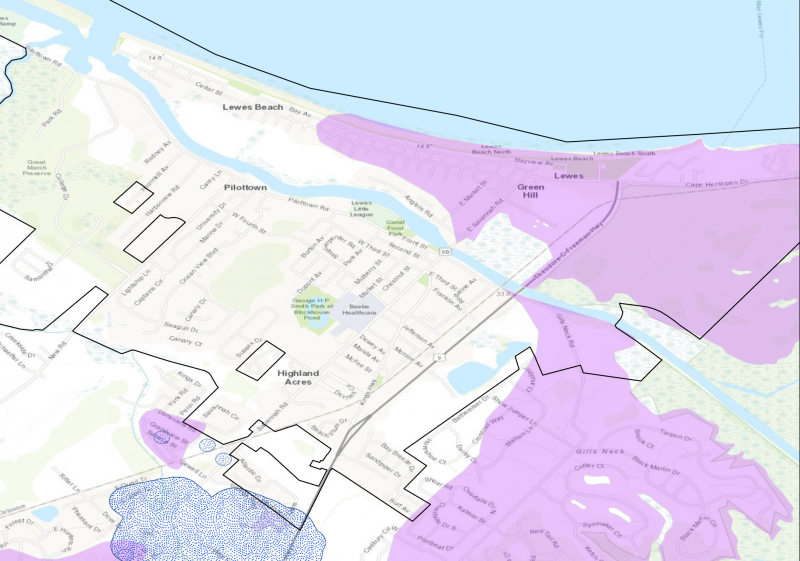The Lewes Planning Commission is recommending the maximum lot coverage for properties within the defined excellent recharge area be capped at 50 percent.
The proposed ordinance would apply to all properties – regardless of their zoning – within the overlay area, which comprises much of Lewes Beach and most of Gills Neck Road.
The existing ordinance, which was adopted in 2008, allows a maximum of 20 percent lot coverage on all properties within the excellent recharge area, as defined by the state. Applicants can increase lot coverage to 50 percent with an environmental impact assessment report that shows post-development water recharge will be no less than pre-development recharge.
The proposed ordinance eliminates the environmental impact report, but requires all driveways, sidewalks, patios and decks to be made of permeable pavement or materials.
Commission Chair Drew McKay said it’s time for the city to address how to protect the area and prevent problems in the future.
“This is not a 2100 problem; this is a 2021 problem,” he said.
The latest version of the ordinance that planning commission members recommended is different from what they considered a month ago. That iteration allowed maximum lot coverage to increase to 60 percent with implementation of at least three runoff reduction practices, such as a green roof, rain barrels, rain gardens or pervious pavement.
After hearing from environmental experts at a March 29 joint workshop with mayor and city council, commissioners determined 60 percent was too much coverage. At an April 1 meeting, many planning commission members expressed concern that even 50 percent lot coverage made them feel uncomfortable, but they agreed to move forward anyway.
The vote was 7-2, with Commissioners John Nehrbas and Melanie Moser each voting against, but for entirely opposite reasons.
Nehrbas dissented because he believes the proposed ordinance is too restrictive, and allowing property owners to institute runoff reduction practices should be permitted to increase lot coverage.
Moser opposed because she believes 50 percent lot coverage is too great without requiring additional water runoff offsets.
Commission Vice Chair Kay Carnahan said the latest version of the ordinance is much better than what was previously proposed and what’s currently on the books.
“This is a much fairer approach,” she said. “It’s thoughtful and helps homeowners understand how their property works, and what they need to do to live in harmony with it.”
Experts offer information
City officials called upon two experts to educate mayor and city council and the planning commission on the state’s regulations for source water protection. They also provided a history of how excellent recharge areas were developed in the early 2000s.
Steve Smailer, program manager for the Department of Natural Resources and Environmental Control’s Division of Water, worked for the department in 1996 when Congress passed amendments to the Safe Drinking Water Act. He then worked as the principal hydrologist with the state to develop a source water protection plan that was approved by the Environmental Protection Agency in 1999. Pieces of that plan became the state’s Source Water Protection Act that was passed in 2001.
State law mandates all jurisdictions of 2,000 or more residents adopt an ordinance that addresses excellent recharge areas; however, what’s in each town’s ordinance is up to town officials.
“Its intent was to provide municipalities with the resources to enact the protective measures themselves,” he said. “Legislators did not give DNREC the authority to enact the protective ordinances. DNREC provides the tools and information to the municipalities to do it.”
During that same time, A. Scott Andres, a hydrologist with the Delaware Geological Survey since 1984, worked to identify source water protection and excellent recharge areas throughout the state. Maps were completed and published in 2004.
“I reviewed the work I did for the Lewes/Cape Henlopen project area and don’t see any reason to change the lines on the map at this point,” he said.
He said source water protection and excellent recharge areas were done separately and don’t necessarily directly relate to each other.
Recharge areas are designed to manage water resources as a whole, whereas source water protection works to preserve the water quality of a municipality’s drinking water wells.
“What’s happening on your beach side has no impact on your wellhead area,” Andres said. “I would say it’s not appropriate to consider those two areas equivalent or consider recharge protection on the beach side area to be less important than protecting your well. You’re protecting different assets in your town for different time scales.”
Andres said the city’s excellent recharge area is keeping saltwater under Lewes Beach at bay.
“The issue on the east side of the canal is all about maintaining freshwater pressure to keep the saltwater from getting underneath your island,” he said. “The other issue is managing stormwater. You don’t want to pave everything over or you’re going to have a lot of runoff that impacts both public and privately held infrastructure in a big way.”
Sea-level rise is also a factor, he said, with sea levels rising about 2 to 3 millimeters per year. A well near the Lewes Public Library has collected data over the last 25 years, showing significant rise in the water table a half-mile inland.
“As sea level rises, the water table will rise,” Andres said. “This is going to have a profound effect on Lewes and all coastal communities in Delaware. What will happen over time is you will lose the amount of storage volume in the ground available to you for short-term events [like coastal storms or lunar tides], and eventually, if sea levels rise as predicted by 2100, there won’t be any land anyway. You have a long-term planning horizon where you have much bigger issues to deal with than groundwater recharge.”
At the planning commission’s April 1 meeting, commissioners also made recommendations that would apply to the entire city. Receiving unanimous support was a recommendation to encourage city officials to use permeable pavement/material for roads, sidewalks and parking lots when feasible. City engineer Charlie O’Donnell said porous asphalt streets typically cost 37 percent to 60 percent more than traditional pavement.
Commissioners also unanimously supported a recommendation encouraging all residents to use runoff reduction practices to do their part in avoiding problems.
McKay described the recommendations as aspirational, but many members of the planning commission said they would like to revisit the issue to consider similar lot-coverage measures throughout the entire city.
Nick Roth is the news editor. He has been with the Cape Gazette since 2012, previously covering town beats in Milton and Lewes. In addition to serving on the editorial board and handling page layout, Nick is responsible for the weekly Delaware History in Photographs feature and enjoys writing stories about the Cape Region’s history. Prior to the Cape Gazette, Nick worked for the Delmarva Media Group, including the Delaware Wave, Delaware Coast Press and Salisbury Daily Times. He also contributed to The News Journal. Originally from Boyertown, Pa., Nick attended Shippensburg University in central Pennsylvania, graduating in 2007 with a bachelor’s degree in journalism. He’s won several MDDC awards during his career for both writing and photography. In his free time, he enjoys golfing, going to the beach with his family and cheering for Philadelphia sports teams.





















































